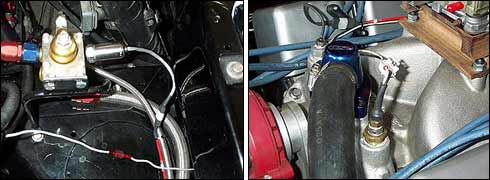
3. Route all cables
separate from ignition sources, plug wires,
distributors, electric fuel pumps, power wires
and battery cables.

When the Data Logger is mounted in the car,
it can be installed at any angle. But remember,
the front panel should be easily accessible
so that you can plug in the printer cable, adjust
the settings or read the built-screen on the
computer. In this application, the computer
is mounted on the rear axle kick-up on a late
model Firebird, facing rearward. In other applications,
racers have found that a mount on the roll cage
close to the passenger side door works well
too. Just keep in mind that the unit should
be mounted away from ignition components.
4. Do not mount
the computer within three feet of any ignition
sources. Examples include MSD boxes, coils,
timers or distributors.
 The
sensor should be mounted so the cable pulls
in the direction of the lower shock mount bracket
or a similar location. With the weight of the
car on the suspension, mount the cable to the
lower mounting point with the cable extended
4-inches from the sensor. This is the neutral
position of the sensor and will allow for 4-inches
of travel in each direction. After mounting
the sensor to the chassis and mounting the cable
to the lower mounting location, slowly jack
the car up, making sure that the jack is securely
under the frame of the car. This insures that
when the rear suspension is fully extended,
the sensor is not overextended. The
sensor should be mounted so the cable pulls
in the direction of the lower shock mount bracket
or a similar location. With the weight of the
car on the suspension, mount the cable to the
lower mounting point with the cable extended
4-inches from the sensor. This is the neutral
position of the sensor and will allow for 4-inches
of travel in each direction. After mounting
the sensor to the chassis and mounting the cable
to the lower mounting location, slowly jack
the car up, making sure that the jack is securely
under the frame of the car. This insures that
when the rear suspension is fully extended,
the sensor is not overextended.
5. The RPM sensors
were originally "unipolar" and would only respond
to the silver or black (non-red) end of the
trigger magnet. New versions of the data logger
use different sensors that respond to either
end of the magnet. The air gap between the sensor
and the trigger magnet should be set between
0.100 and 0.250-inches.

Pressure and temperature sensors are part of
the normal Data Logger installation process.
The fuel pressure sensor can be installed in
many different locations (in-line, at the carburetor
and so on), however a logical location is at
the fuel pressure regulator. It is also possible
to mount more than one sensor in something such
as the fuel line, so that pressures can be measured
before and after the regulator or right at the
carburetor. Coolant temperature sensors are
most often installed in the water cross over
on the intake manifold, however locations in
cylinder heads are not uncommon.

|